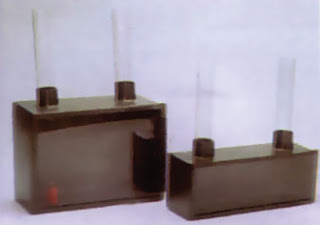Convection currents in liquids
When a vessel containing a liquid is heated at the bottom a current of hot liquid moves upwards and its place is taken by a cold current moving downwards. Unlike conduction, where heat is passed on from one section of the substance to another as described in the previous post ( transmission of heat energy explained), the heat is here actually carried from one place to another in the liquid by the movement of the liquid itself. This phenomenon is called convection. The same process occurs when a gas is heated.
Experiment to demonstrate convection currents in water
| Convection currents in water |
Convection currents in water may be shown by filling a large spherical flask with water and dropping a single large crystal of potassium permanganate ( KMnO4) to the bottom of it through a length of glass tubing. A finger is placed over the end of the tube, which is then removed, together with the colored water it contains.
After a short time it circulates down the sides of the flask, showing that a convection current has been set up.
Explanation of convection currents
When a portion of liquid near the bottom of a vessel is heated it expands. Since its mass remains unaltered, it becomes less dense ( you remember that Density = mass / volume ), and therefore rises. Thus a warm convection current moves upwards; for the same reason a cork rises in water or a hydrogen-filled balloon rises in air. In effect, convection is an application of Archimedes’ principle. For further illustration please read Balloons and floating bodies.
Convection in air – Ventilation by convection
| Windmill pattern |
 |
| Ventilation by convection |
The air convection current rising from an electric lamp may be shown with the aid of a small windmill.
A suitable windmill may be cut with scissors from thin card or aluminium foil to the pattern on the image above. The vanes are slightly bent and the mill, pivoted on a piece of bent wire, is held over the top of an electric lamp. When the lamp is switched on the windmill rotates in the upward hot air current. A device similar to this is often used to produce a glimmering effect in domestic electric heaters of a type which are disguised to resemble glowing coal fires.
In this way a constant flow of fresh air was maintained through the mine. The image above shows a laboratory model to illustrate this method of ventilation. It consists of two wide glass tubes projecting from the top of a rectangular wooden box with a removable glass front.
A short piece of candle is lit at the base of one of the tubes. When a piece of smouldering brown paper is held over the top of the other tube, the direction of the convection currents will be rendered visible by the passage of smoke through the box.
The domestic hot water supply system
 |
| Composition of the domestic hot water supply system |
The domestic hot water supply system is composed of a boiler, a hot water storage tank and a cold supply tank interrelated by pipes arranged as shown in the image above.
When the system is working a convection current of hot water from the boiler rises up the flow pipe A while cold water descends to the boiler through the return pipe B, where it becomes heated in turn. In this way a circulation is set up, with the result that the hot water storage tank slowly becomes filled with hot water from the top downwards.
It is important to notice that the flow pipe A leaves the boiler at the top and enters the top of the hot tank, while the return pipe B connects the bottom of the hot tank to the bottom of the boiler.
Circulation by convection
| Circulation by convection |
This image shows a glass model which demonstrates the convection currents described above. originally, the water in the lower flask is colored with blue ink, while the tubes and upper vessel are full of colorless water.
When the flask is steadily heated with a Bunsen-burner a hot convection current of colored water rises up the bent tube. After a short time a visible layer of hot colored water collects at the top of the upper vessel. Eventually this layer increases in depth until the upper vessel is entirely filled with hot colored water.
Finally, warm colored water will be seen descending the straight tube. I hope that was fun:). Thanks for visiting and I hope you come back soon.
